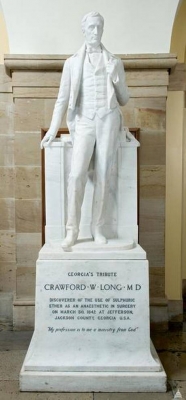
Anaesthesiology, anaesthesia or anaesthetics is the branch of medical science that focusses on and specialises in pain relief for patients, both during and after surgery. It was in the 1840s that the pain-numbing capacities of certain substances were observed and documented, laying down the foundations of this medical specialty that now not only encompasses anaesthesia and pain medicine, but also intensive care and critical emergency medicine.
Who gets the credit?
There is no clarity, however, as to who exactly needs to be credited with the discovery of anaesthesia. There is American physician and geologist Charles T. Jackson, who is believed to have made the suggestion to compatriot William Thomas Green Morton to use sulphuric ether as an anaesthetic. Morton’s successful demonstration of the utility of ether as an anaesthetic took place in 1846 and was pivotal in winning over the public’s confidence.
American dentist Horace Wells is said to have independently conceived the idea of using an anaesthetic agent for surgery, but failed in his demonstration. And then, there is American physician Crawford Williamson Long, who likely employed anaesthetics before either Morton or Wells, but didn’t do enough early on to push his own case.
Born in 1815, Long entered Franklin College in Athens (in the U.S. State of Georgia, later became the University of Georgia) at the age of 14 and graduated in 1835. A year studying medicine with a doctor and a couple more at the Medical Department of Transylvania College, he transferred to the University of Pennsylvania Medical School and received his medical degree in 1839. After spending another 18 months studying surgery in New York, Long set up his own practice in the city of Jefferson and married Caroline Swain in 1842.
The effects of ether
It was on March 30 in the same year that Long first employed ether on a towel as an anaesthetic during a surgical procedure to remove a small tumour from the neck of James M. Venable. Venable had a subsequent operation on June 6 and Long performed a third surgical operation on the patient on July 3. Long employed ether again during the third operation, which was the amputation of a toe.
Long had taken to using ether as an anaesthetic following his observations of the intoxicating effects of nitrous oxide and sulphuric ether. He noticed these during ether frolics that were common during that time and realised that the participants who were inhaling ether in limited quantities were feeling exhilaration, but didn’t become unconscious. It also occurred to Long that those in the party didn’t experience pain while under the influence of the gas, even when experiencing falls and bruises.
After his success with Venable, Long continued to experiment with ether as an anaesthetic, using it whenever possible. This probably includes administering ether to his wife on December 27, 1845 when she was going through labour. If the accounts from Long’s family and those close to him are anything to go by, the childbirth of one of his daughters was also the first use of an anaesthetic in obstetrics (the branch relating to pregnancy and childbirth).
Delays announcement
For reasons that aren’t well established, Long delayed announcing his attempts and experiments with ether. It was only after news of Morton’s successful demonstration with ether nearly four years later started spreading that Long too made his claim, by which time Jackson and Wells too were vying for the honours.
To criticism that Long didn’t do enough to promote such a discovery early, he stated:
“Had I been engaged in the practice of my profession in a city, where surgical operations are performed daily, the discovery would, no doubt, have been confided to others, who would have assisted in the experiments; but occupying a different position, I acted differently, whether justifiable or not.”
Along with fewer opportunities to employ ether, Long also added that his belief (following the second Venable operation) that the anaesthetic’s effect only lasted for a short while, rendering it useless for long, complex procedures, as another reason for not announcing his experiences sooner.
Long shifted to Athens in 1851 and set up a successful practice there, spending the rest of his life in the city. The priority to the claim as to who discovered anaesthesia wasn’t settled by the time he died in 1878, and remains to be the case even now.
Picture Credit : Google




